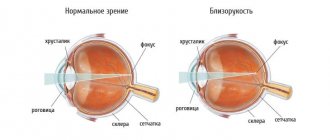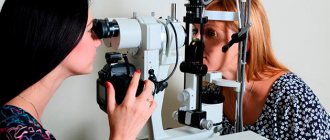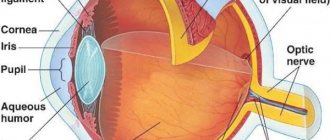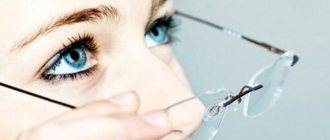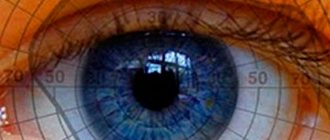Myopia and farsightedness are the two most common vision disorders.
Vision minus 5 means that a person develops an average degree of myopia. He sees very poorly, this is especially noticeable at dusk. Myopia develops quickly in children and adolescents.
Causes of myopia
Thanks to the development of science, today this visual impairment is well studied. In ophthalmology, the disease is called myopia.
In this article
- Causes of myopia
- Imaginary myopia
- How do people with varying degrees of myopia see?
- Treatment of myopia
- Prevention of myopia
At the physiological level, the pathology is associated with a defect in the shape of the eye lens. Under the influence of a number of factors, it changes and becomes more elongated. As a result, the optical axis of the eye increases, as a result, the refraction of light rays occurs at the wrong angle. The image is ultimately formed not on the retina, as with healthy vision, but in front of it.
Myopia happens:
- congenital;
- acquired.
In the first case, the disease is detected in a child in the first year of life. Experts believe the cause of its appearance is a genetic predisposition. If mom or dad had vision problems, then with a probability of up to 50% they will be passed on to the child. If the disorder was diagnosed in both parents, then with a risk of up to 75% the disease will be passed on to the baby.
In addition, the cause of congenital myopia during pregnancy can be:
- disorders during intrauterine development;
- bad habits;
- poor nutrition;
- infectious diseases;
- fetal hypoxia;
- premature or difficult birth.
Factors contributing to the development of myopia during life are:
- prolonged eye strain;
- violation of work and rest schedules;
- poor lighting when working with small parts or reading for a long time;
- long periods of work at the computer without a break.
Very often, myopia appears in schoolchildren when visual stress increases. During this period, it is very important to pay attention to the problem, since without proper treatment the disease will progress.
Correction methods
If a child is diagnosed with vision of 0.5 or -0.5, parents immediately ask themselves: are glasses needed to restore full visual function? This question can only be answered by an ophthalmologist who can realistically assess the degree of progression of the disease. As a rule, for those who do not know whether glasses are needed with vision 0.5, doctors prescribe wearing glasses with diverging lenses. In this case, the development phase of myopia requiring correction is taken as the basis. In order not to make a mistake in choosing the diopter value of lenses for children and adolescents, atropine is instilled into the eyes. It helps to relax the eye muscles and accurately determine the state of vision.
Additionally, to correct vision, it is recommended to perform special exercises for the eyes, follow a gentle diet and physical activity, and limit heavy lifting.
Imaginary myopia
Deterioration of vision is not always associated with physiological changes in the lens of the eye. Decreased visual acuity sometimes occurs due to imaginary myopia. During prolonged eye strain, a spasm of accommodation occurs. This phenomenon is called imaginary or false myopia.
Imaginary myopia is a malfunction of the eye (ciliary or ciliary) muscle. This part of the eyeball is responsible for focusing. When viewing objects at a distance, the ciliary muscle relaxes, but when viewed close, on the contrary, it becomes tense. It changes the shape of the lens, allowing us to see equally well near and far. When a spasm occurs, the muscle stops relaxing and is in constant tension. As a result, a person develops all the same symptoms as with myopia, that is, he sees well up close, but at a distance the contours of objects become blurred.
This violation is caused by:
- increased visual stress;
- osteochondrosis of the cervical spine;
- constant work at the computer, frequent use of gadgets and watching TV.
Spasm of accommodation occurs in children and adults. As a rule, schoolchildren and students who have to study a lot encounter this phenomenon. In adults, the disorder is often caused by prolonged, uninterrupted work at the computer.
Spasm of accommodation is not an ophthalmological disease, however, it is necessary to take measures to eliminate it, since in the future it can lead to vision problems. There are three ways to get rid of false myopia:
- eye drops (usually prescribed “Atropine”, “Tropicamide”, “Mydriacyl”, “Cyclomed”);
- physiotherapy (carried out in a medical institution);
- gymnastics for the eyes.
Only a specialist can determine whether a person’s myopia is false or true. Therefore, at the first signs of myopia, you should visit an ophthalmologist.
vision minus 5
2015-11-05 15:41:48
Olga asks:
Hello, my boyfriend has minus 9 vision, can he engage in tourism and active sex? Thanks for the consultation.
November 10, 2015
Elena Stanislavovna Prokhvachova answers:
Hello Olga. The presence of myopia is not a contraindication to tourism or any type of sex.
However, with myopia (especially high degree) degenerative changes in the retina are possible, so your young man should be examined by a retinologist (retina specialist).
After the examination, the doctor will give individual recommendations, taking into account the condition of the retina and your friend’s active lifestyle.
2014-08-14 17:42:06
Irina asks:
Hello! my friend is 32 years old, she has no vision at all in one eye: 2nd degree myopia, retinal detachment, and in the other her vision is minus 5. Is she entitled to a pension for this disease? Thank you in advance!
August 17, 2014
Elena Stanislavovna Prokhvachova answers:
Hello Irina. Your friend should go to the clinic at her place of registration to see an ophthalmologist. After the examination, the doctor will assess the chances of assigning a disability group.
- 2014-08-03 08:14:43
- Elena asks:
- Hello, I seem to have hair in my eye, I wear glasses with minus five vision and I am 44 years old, there is also redness in the eye, what could it be?
05 August 2014
Prayer Oksana Vasilievna answers:
If you mean floating threads before the eyes, then this is destruction of the vitreous body. If a large number of threads appear, you should contact an ophthalmologist and check the condition of the retina. Redness of the eyes is not associated with this. Before you can say what might be causing it, you need to conduct an examination.
2013-11-20 12:42:59
Julia asks:
Hello! I have minus 18 vision in both eyes, thinning of the retina in the periphery (grid), I had coagulation done. I am monitored every six months. What physical exercises can I do? I want to remove my tummy, sides, and reduce the size of my hips. Is this possible with the help of any physical exercises in my case? Could it be an exercise bike or a treadmill? Thank you very much!
- November 25, 2013
- Kozina Ekaterina Nikolaevna answers:
- Dear Yulia, your body will receive much greater benefit from yoga, massage, and walking. An exercise bike is possible without heavy loads,
How do people with varying degrees of myopia see?
Disturbances that occur in the organs of vision during myopia cause changes in the eyeball, or rather its enlargement. The more the size of the eyeball increases, the more vision decreases.
Myopia causes eye enlargement from 1 to 7 millimeters or more. Every one millimeter deviation from the norm causes vision deterioration by three diopters.
There are three degrees of myopia:
- first (or weak) - vision is reduced to -3 diopters;
- second (or average) - vision is reduced from -3.25 to -6 diopters;
- third (high or strong) - vision is reduced by more than -6.25 diopters.
How do people with myopia see? When vision is slightly reduced, that is, the first degree of the disease is diagnosed, a person sees 90%. In everyday life this manifests itself as minor discomfort. For example, it is difficult to see the number of a house on the opposite side of the street or read a sign on a store from a distance. At the same time, no difficulties arise when viewing objects close up or reading. Sometimes the picture on a TV may become blurry if it is located at a considerable distance. For example, by the way a child sees notes on the board, you can understand whether he has vision problems. In this case, you can do without glasses. However, if a certain action requires special concentration, it is still better to use correction means. So, you should wear glasses while driving a car.
It should be noted that even with a low degree of myopia, you cannot select glasses yourself. Incorrectly selected optical aids can aggravate the problem. In addition, you may experience a headache or painful sensations in the eyes. As you might guess, with each subsequent degree of myopia a person sees worse and worse. With moderate myopia, people have to squint to see objects in the distance. Already at a distance of several meters, things take on blurry outlines. In such a situation on the street, it is difficult to distinguish faces, they seem blurry, and features cannot be discerned. To understand how people with myopia see the world, imagine a blurry photo. At a distance of 20-30 centimeters, people with myopia still see well. When high myopia occurs, people see objects only at arm's length. Vision is only 1-2%. A person sees the text only if they hold a piece of paper close to their face.
In general, myopia is characterized by poor distance vision, but people with myopia can see objects well at close distances. How a person with visual impairment sees objects is checked in the ophthalmologist’s office using special tables. The most famous of them is the Sivtsev table. Many people have been familiar with the test using it since childhood. It consists of 12 lines. From top to bottom, the font size decreases.
Depending on whether a person sees all the letters or with errors, the acuity of his vision is determined.
Vision minus 5 in a 5 year old child
It must be said that the massive development of myopia, especially in children, may well be a sign of evolution. If earlier a person needed to see well into the distance in order to live (say, when hunting), the eyes adapted to this.
- Even if the operations were performed in the Fedorov center, this does not remove the indications for a caesarean section.
- If a woman says that she used to have myopia minus ten, but now everything is fine, obstetricians spit on it, don’t pay attention and perform a caesarean section.
Author, why are you opposed to the Constitutional Court? My vision is about the same as yours. I hesitated for a long time, thinking about how best to give birth, because I have such vision and indications for a CS and at the same time no one insists that I can give birth myself.
Rosette
30 Jan 2012, 16:43
My cousin had ST, her vision dropped by a diopter. She has a small minus.
Strengthening the retina with a laser is not scleroplasty. As already mentioned above, before pregnancy you should have your retina checked, preferably in a specialized eye clinic (for example, Fedorovskaya). Pregnancy and childbirth do not greatly affect vision if it is normal.
But if you think about correction, then hormonal levels are very important here (why, how, I don’t know, but it influences). Corrective surgery is performed after 1.5 years after breastfeeding (or after childbirth, in the case of artificial feeding). All from personal experience.
I have -4.5 and -5. She gave birth on her own, pushed incorrectly, so much so that she walked around with red eyes for 3 weeks, but her vision did not deteriorate as a result.
Macherry
I have -5 in both eyes, I went to the ophthalmologist when I was pregnant. I wrote a conclusion: exclude the period of pushing. I was very upset, I thought everything was guaranteed for a Caesarean. I arrived at the maternity hospital, the doctors looked at this piece of paper and threw it away.
I have minus 2!!! I just found out today! And also problems with the fundus of the eye, retina, in short. They told me to come back next month and they will decide on the issue of delivery!!! It seemed to me that I have no problems with vision at all, I don’t need glasses or contacts, apparently the whole problem is the fundus and intracranial pressure and the retina of the eyes!
https://www.youtube.com/watch?v=hyDc1AXc86g
Margot’s vision is very important, I don’t know how they don’t check it for you! If there are problems with the fundus of the eye, then pushing can have a bad effect on the eyes, I read a lot on this topic, you need to be able to push correctly so that your vision doesn’t deteriorate….
But sometimes excessive growth of the eyeball immediately leads to myopia, which can progress with age, although, fortunately, reaching only a weak or moderate degree.
But in some cases, mainly when basic conditions of visual hygiene are not observed or when the body is weakened as a result of serious illnesses (for example, rubella), the progression of myopia continues into adulthood, when there is no talk of any growth of the eyeball.
One of the most important things I realized is that free courses and advice don’t work. We never appreciate what we get for free. And when you pay, you work much more seriously.
Why do you need to measure the refraction of the eye?
Each of us has an individual structure of the lens and cornea, the relationship between them, unlike any others, hence the statement that the human optical system is unique. Throughout life, refraction changes and, along with it, the quality of vision. General trends will include:
- newborn babies are farsighted,
- by the age of 20, young people are one third farsighted, and about 40% suffer from myopia, the rest have normal vision,
- Natural aging of the body also affects refraction. Senile farsightedness (myopia) is a very common phenomenon.
Measuring refraction is very important when performing vision correction. It allows you to choose the right glasses and monitor the progress of treatment. This is of particular importance in childhood and adolescence (at this time, vision correction allows you to correct defects and preserve the child’s vision).
It is also important to monitor changes in refraction in old age; diagnostics will help monitor the treatment process or the level of vision loss.
Measuring refraction will allow you to plan laser correction and determine its results.
What are the symptoms and causes of myopia? What are the degrees?
The number of people with visual impairments is growing every year. The most common types are farsightedness and nearsightedness. If a person has a vision of minus 5, we can say that he has myopia.
Myopia (myopia) comes in three degrees. With weak myopia, vision is -3 or lower, with a moderate degree - from -3 to -6, with a high degree of myopia - more than -6. For example, vision minus 5 means average degree of myopia.
Causes of vision minus 5, or myopia
The causes of myopia minus 5 can be different. The main ones are the following:
- Irregular shape of the eyeball: when the eyeball is elongated, light rays, when focused, do not reach the retina.
- Very strong refraction of light rays. Due to the strong refraction of the optical system of the eye (cornea, lens), light rays converge into focus not on the retina, but in front of it.
- Heredity. A physiological predisposition to poor vision is inherited. Those at risk are those who have both parents suffering from this disease.
- Primary weakness of accommodation (the ability of the eye to view objects at different distances). It leads to stretching of the eyeball.
- Weakening of scleral tissue (the outer white layer of the eyeball). Helps increase the size of the eyeball under the influence of high eye pressure.
- Failure to comply with visual rules. These are eye strain, sitting for a long time in front of the TV or computer, insufficient lighting and many other reasons.
- General weakening of the body. Occurs due to overwork and poor nutrition. It can be the result of many diseases - infectious diseases, allergies, musculoskeletal disorders, brain injuries and other diseases.
Features of lifestyle with vision minus 5
Most often, myopia develops in children 7-15 years old. After this, the disease may worsen or remain at the same level. It depends on the person's lifestyle. With eye myopia minus 5, you need to make some lifestyle changes:
- Do not overload physically, avoid lifting heavy objects, and do not make sudden movements.
- Give your eyes rest more often. It is necessary to alternate visual tension with eye relaxation. Walking in the fresh air helps a lot.
- Set up your workplace correctly. The main role is given to good lighting. Do not allow direct sunlight to enter your eyes.
- Sports activities. In this case, it is necessary to exclude those sports that require a lot of stress. The best thing to do is swimming.
Treatment of myopia
After a diagnosis of myopia is made, the patient is prescribed glasses or contact lenses. Optical products will help you see better in everyday life. But they do not solve the problem of poor vision. Correcting myopia requires medical intervention. There are currently three main treatment options:
- medicinal;
- physiotherapy;
- surgical.
Drugs intended for the treatment of myopia improve blood circulation in the organs of vision, relax the ciliary muscle, and promote metabolic processes. They are available in both drops and tablets. The dosage and course of drug therapy is determined by the doctor. It is worth noting that medications only stop the development of myopia and prevent complications. It is impossible to completely get rid of pathology with the help of drugs alone.
Among the medications that may be prescribed:
- “Irifrin” drops - the product helps to constrict blood vessels, dilate the pupil and relieve spasm of the ciliary muscle;
- Strix tablets are dietary supplements that improve blood supply to the retina;
- drops "Taufon" - the drug contains an amino acid that has a beneficial effect on metabolic processes in the organs of vision.
You cannot choose medications on your own. Any means, even if they are vitamins or dietary supplements, must be recommended by a specialist.
One of the effective methods of treating myopia is physiotherapy. The procedures are carried out in a medical facility. Among them:
- Electrical stimulation is the application of a low electrical current to the structure of the eyes through the eyelids. The procedure improves blood circulation and promotes the supply of nutrients.
- Impact on the organs of vision with an infrared laser. This method improves microcirculation of intraocular fluid and blood circulation.
- Endonasal electrophoresis. Special electrodes containing medications are inserted into the nose, and a low-intensity electric current is passed through them. In this way, medications are delivered to the back of the eyes.
The choice of treatment method depends on the degree of myopia and the general condition of the patient’s body. The most modern and effective way to eliminate myopia today is laser correction. This method is safe and has a short recovery period. Laser surgery is performed for both mild and severe myopia. In almost 100% of cases, this method guarantees complete restoration of vision. This method of vision restoration is recommended for most patients. However, it has contraindications.
Thus, laser correction is not performed in the following conditions:
- visual impairment of more than -8 diopters;
- retinal complications;
- progressive myopia;
- age under 18 years;
- pregnancy and breastfeeding.
The most common vision diseases
Myopia is not the only eye problem. There are a lot of eye diseases. Therefore, you need to take care of your eye health in a timely manner. Moreover, even the flu or a sore throat can cause complications in the eyes.
The most common diseases:
- Inflammation of the mucous membrane;
- Inflammation of the eyelid;
- Destruction of the vitreous body;
- Corpus luteum degeneration;
- Glaucoma and cataracts.
This does not include vision problems such as astigmatism. Modern children and adolescents are very often born with such complex eye diseases. And to correct such vision, glasses are required and the eyes must not be overstrained, otherwise vision will deteriorate relentlessly.
Inflammation is a very frequent visitor. If the eye begins to tear, redness appears, or even worse, pus begins to come out of the eye, then most likely an infection has been introduced into the eye and inflammation of the mucous membrane has occurred on the face. The worst thing about this kind of inflammation is that it appears suddenly. Treatment is not so simple - compresses, drops prescribed by the doctor and rest. Sometimes even antibiotic drops are prescribed to kill the infection. The cause of this inflammation is bacteria and viruses.
Inflammation of the eyelids has a similar nature. They swell, turn red and itch. The eyelid also contains sebaceous glands that are responsible for lubricating the eye. And when these glands become clogged due to inflammation, antibacterial drops and compresses are also prescribed. But such inflammation can become chronic, and barley can also stimulate exacerbation. With such a variety, how to restore vision in 1 day? Some scientists say yes. But as experience shows, this is more a myth than the truth.
Cataracts are another scourge of our time. With age, the image becomes blurry and often doubles. These are the main signs of lens aging. It becomes less flexible, and the image suddenly begins to lose its quality. Moreover, cataract is an acquired disease; it is extremely rare to be congenital. It is impossible to completely cure or avoid cataracts; the lens changes its size with age, the water content in it decreases and, as a result, vision deteriorates. Surgery to replace the lens with a lens can help with cataracts. The operation may involve complications, intraocular inflammation, but this happens extremely rarely.
The next problematic disease is related to intraocular pressure - glaucoma! Moreover, the main characteristic is an increase in eye pressure, but it also happens the other way around. The reasons need to be clarified. Problems begin with the outflow channels of the eye fluid and against this background glaucoma develops.
Why is high blood pressure dangerous? It leads to nerve fiber injuries and damage to the optic nerve. If more than half of the nerve fibers have already been affected by the disease, then serious problems with vision begin, up to the loss of part of the vision. If the case has not yet started, then drops are prescribed to reduce eye pressure. With glaucoma, such caps have to be used throughout your life. Heredity, high blood pressure, aging, and myopia can contribute to the development of glaucoma. Blood vessel diseases and even diabetes can stimulate development.
There is a place in the eye that guarantees clarity - it is called the macula or macula. And degenerative processes in this place also occur in old age. In turn, this disease leads to thinning of the retina. Signs include blurred vision - there may be black spots in the image. Unfortunately, this disease is still poorly treated. There is only supportive therapy. In the wet form, special injections may be prescribed to pump out excess fluid.
Prevention of myopia
Visual impairment can occur at any age. In the modern world, excessive fascination with gadgets often leads to a decrease in visual acuity. After working at a computer during the day, a person returns home and again picks up a tablet, phone, or watches TV. As a result, the eyes do not get rest. People who, due to the nature of their work, have to spend a long time in front of a monitor, are recommended to do eye exercises at least once a day.
The best prevention of ophthalmic diseases is the correct approach to work and rest hours. Good vision will be promoted by an active lifestyle, a balanced diet with sufficient vitamins.
Visual acuity and vision 1: what is it?
What is visual acuity? In Russia and the CIS countries, this value is measured in conventional units and its indicators can be different: 0.1; 1; 2, etc. They range from zero (i.e. complete blindness) to infinity.
It is worth explaining that visual acuity is the ability of the eye to separately see two points located at a certain distance from each other.
In the CIS countries and Russia, it is customary to check this value using various posters (Golovin and Sivtseva in adults and Orlova in children).
With visual acuity equal to one, 10 lines are clearly visible at a distance from the table of 5 m (this is considered normal). If 12 lines are visible, then the level of vision is 2. On the right side of the lines, indicators of this value are written depending on the number of lines that the subject sees at a distance of five meters. That is, if he can distinguish only 1 line, then the indicator is 0.1; if 2 – 0.2, etc.
Vision index 1
What does visual acuity one mean? It is important to understand that this is the normal level of vision (or 100%). According to standards, an eye with this indicator is able to distinguish between two separate points with an angle between them of 1 minute or 1/60 of a degree. In Western terminology, this value is equivalent to 20/20.
If this value is below one, then treatment is necessary.
Tables to check
Special posters are used to carry out diagnostics. They may contain images of various designs, letters, icons or hooks.
- The most popular among Russian ophthalmologists is a poster depicting letters (Sivtsev’s table).
- Sometimes doctors use the Golovin table, which shows rings with ruptures.
- When checking children, ophthalmologists prefer Orlova's poster with different pictures.
Letters or pictures are located on twelve lines, and their size decreases with each line (starting at the top and going down). On the left side of each line, the symbol “D” indicates the distance from which, with good vision, the subject should see all the symbols. For the top line it is 50 meters, and for the bottom line 2.5. On the right side of the lines, the letter “V” indicates visual acuity indicators, which are correct when the subject reads symbols from 5 meters. This indicator is equal to 2 if the subject distinguishes the bottom line and 0.1 if he sees only the first.
How is the diagnosis carried out?
The subject is seated five meters from the poster. Next, the doctor diagnoses each eye separately. He starts with the right and then moves to the left.
- First, the ophthalmologist asks you to name a series of letters located on the tenth line of the table. The correct answer means that the visual acuity index is equal to one.
- If the subject names the letters on line 10 incorrectly or often makes mistakes, the doctor moves to the top, and if the answer is correct, he goes lower and lower until the patient starts making mistakes again.
- The last line that he can distinguish and will indicate visual acuity (if he sees all 12 lines, then this value will be 2).
In ophthalmology, people are known who have developed visual abilities up to five or six units. This was manifested in the fact that they clearly saw objects located at a distance of 100 meters and further. There have been exceptional cases in the history of medicine when this figure was sixty units and a person could see the rings of Saturn in the starry sky, which with an average value (i.e. one) can only be seen using a telescope.
Entry in the patient's card
After diagnosis, the doctor makes entries in the patient’s chart. Most often they are the following: ViS OD and ViS OS. These symbols are quite easy to decipher. The first entry refers to the right eye, the second, respectively, to the left. If the visual function of both eyes is normal, 1.0 will be written next to each entry.
Snellen chart
The Snellen table is more often used by foreign countries, especially the USA. Just like on Sivtsev’s poster, large letters occupy the top lines and their size decreases downwards.
The poster is made in such a way that if a person has 100% vision, then he can read each line from a distance of 60, 36, 24, 18, 12, 9, 6 and 5 meters (which equals 100, 70, 50, 40, 30, 25 and 20 feet respectively) up to the red line.
For diagnosis, the subject is seated at a distance of 6 m (20 feet) from the poster. He is asked to close one eye and read the letters with the other. The lowest row that the patient can distinguish and will indicate his visual acuity.
- Normally, this figure is 6/6 (or 20/20). In this case, the subject can read line 8 from a distance of 6 m (20 feet).
- If he sees only 5 lines, then the visual acuity on the Snellen scale is 6/12 (20/40). In this case, to read line 5, he needs to approach the poster at a distance of 6 m (20 feet), while a subject with good vision will see this line from 12 meters (40 feet).
If from a distance of 6 meters a person sees only one, the first line, then in the United States he is recognized as “legally blind.”
To summarize, we can say that if a person has a normally developed visual apparatus, then his visual acuity will most often be equal to one, sometimes two.
Many people confuse visual acuity with refractive ability. The first quantity is represented only by positive values, which range from zero to infinity. Moreover, one is an average value, and two is a good indicator. The refraction of the eyes is measured in diopters, the indicators of which can be either negative or positive. Negative diopters indicate that a person is developing myopia (nearsightedness), and positive values indicate hyperopia (farsightedness). The normal refraction value is zero (indicating good eye health).
You might be interested in this:
How is visual acuity 0.5 determined?
In Russia, the rules for determining visual acuity have not changed since the times of the USSR and are determined by fractions of a unit. Indicator 1.0 – normal vision, 1.2–0.1 – visual acuity is reduced. The check is done according to the Sivtsev or Golovin table; there is no difference in the technology itself, only the signs differ. One contains the letters of the alphabet, and the other contains circles with slots.
Sivtsev table
There are 12 rows in the tables, each with its own size. At the top are the largest letters or circles; a person with normal vision should see them from a distance of 50 meters. A person with normal vision should be able to distinguish the bottom row from a distance of 2.5 meters. On the right of the rows, visual acuity is indicated when tested from a distance of 5 meters. The first mandatory check is done for children upon entering kindergarten and school. But parents should not expect a mandatory check; the sooner the doctor detects abnormalities, the better. In most cases, vision can be completely restored; if for some reason this is not possible, the child is prescribed glasses. Wearing glasses prevents further deterioration of vision.
Both eyes are checked in turn. If a patient from a distance of 5 meters sees all the signs or letters of the tenth line from the top, then his vision is 1.0, if he clearly distinguishes only up to the fifth line from the top, then his visual acuity is, accordingly, 0.5.
Golovin table for measuring visual acuity
